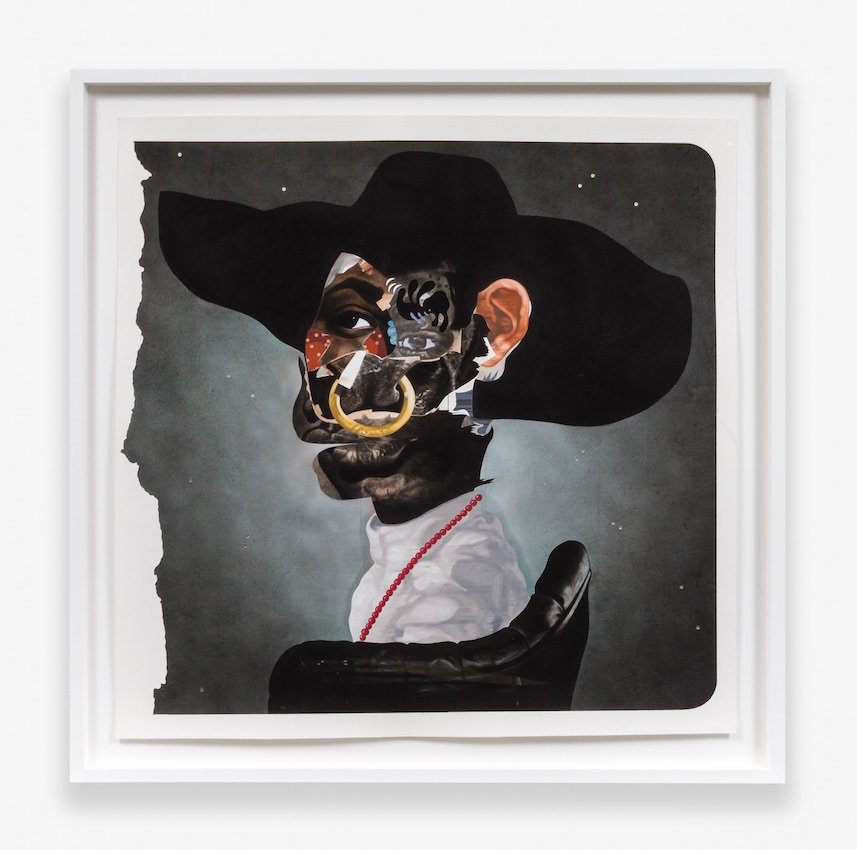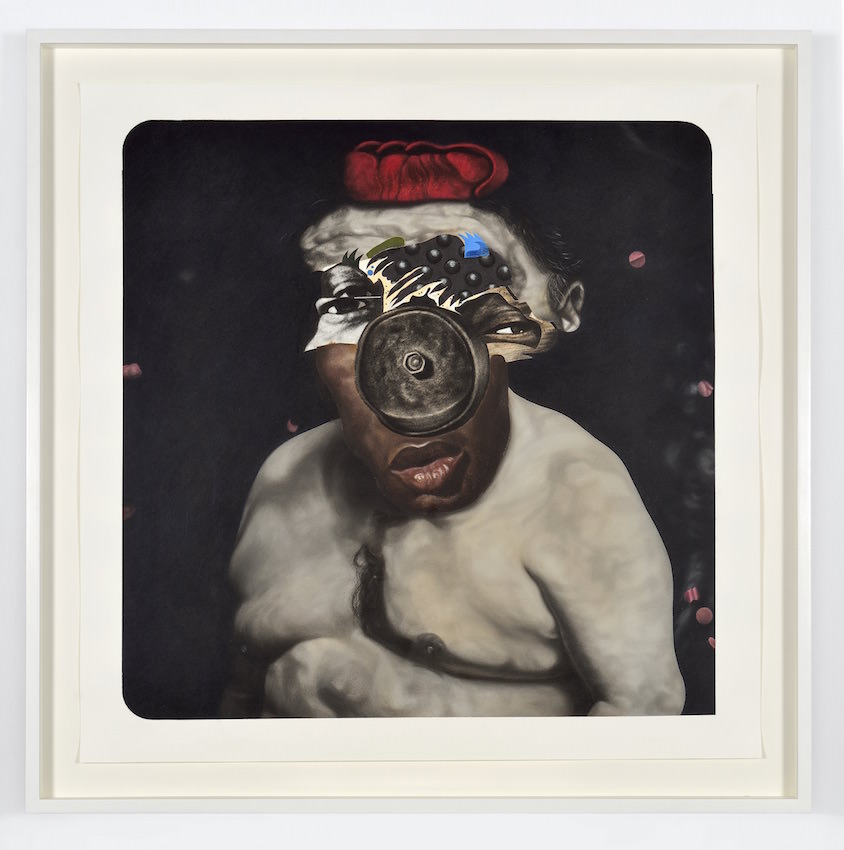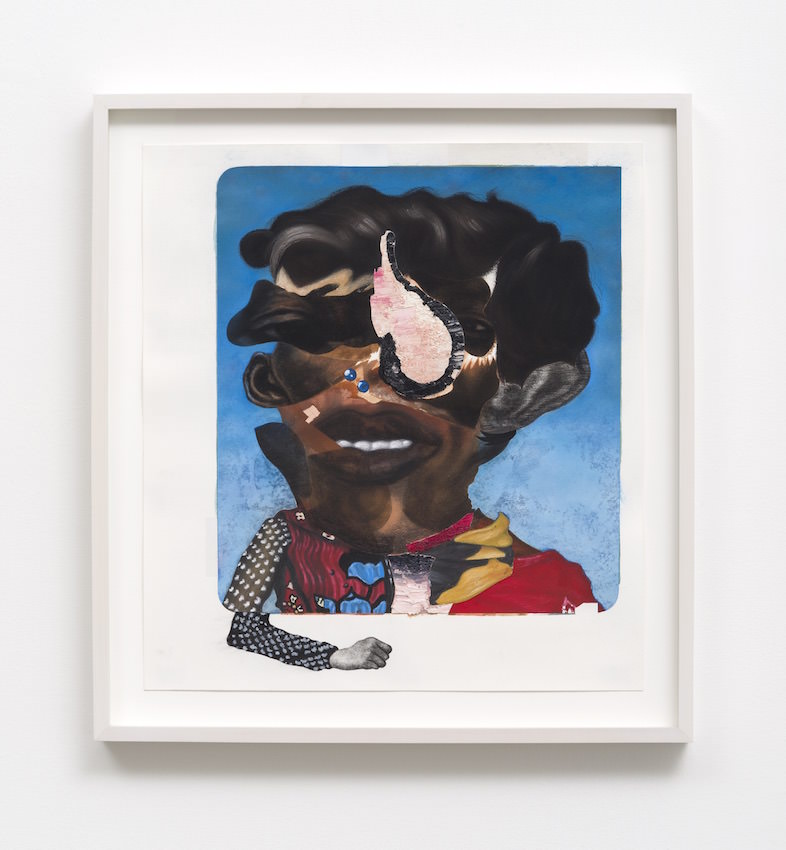When we visited Nathaniel Mary Quinn he was still living at his Bed-Stuyvesant apartment where he had a room he used as his studio. More recently he bought a house in Crown Heights where he now uses the parlor floor as his studio. The price of his paintings has increased by around 660 percent in the last three years. When we were there, some of those paintings, mostly evocative expressionist portraits with an abstract twist, were hanging in the living room.
“All these works are gouache and black charcoal on paper. Everybody thinks it’s like traditional collage and appropriated images from a magazine glued onto paper, but that’s not the case. Everything is applied by hand: I either drew it or painted it onto the actual paper itself,” he told us.

Space Monkey
Quinn’s portraits look collaged but are in fact organically composed. He amasses pictures sporadically from the Internet, newspapers, and magazines and cuts out individual features that he then draws directly onto the work using construction paper to create sharp traces. He insists on not removing these rough edges. “I use the accidental cuts as an instinctual response onto the work,” he said.
When done with one part of the drawing, he covers it and maps out the next section of the piece. “I can’t see what I just did anymore, so I don’t have any idea how this part of the portrait is going to land until I remove it for the first time. What that does is that it functions on a more psychological level because human behavior is based on symmetry,” he said.

17 X 14 inches
To some, Quinn’s process of free association may defy classical notions of beauty. The human brain is known to have an ingrained attraction toward symmetry arising from nature that can be witnessed as the central black hole of a galaxy, for example, or the gracious proportions of the unfolding feathers of a peacock. The Harvard mathematician George David Birkhoff (1884–1944) even developed a theory of aesthetic value based on symmetry, “clearly separable from sensuous, emotional, moral or intellectual feeling.” This means one’s eyes would instinctually and objectively pick up on objects and images that the brain can interpret in depth, space, and context. Through symmetry, the brain is drawn to understandability and predictability, yet Quinn’s process is the exact opposite of that—it is volatile and unforeseeable, even to him.
“If you make yourself blind to what you’re doing, you can no longer depend on what makes sense. It becomes about memories that start to come up in play. They emanate from the storage of your subconscious. Once the work is complete. it tells me what it is,” Quinn said.

Black charcoal, gouache, soft pastel, oil pastel, oil paint, paint stick, acrylic gold leaf on Coventry Vellum Paper
Courtesy of the artist
The artist grew up from the 1970s onwards as the youngest of five boys in the Robert Taylor Homes in Chicago, one of the most infamous housing projects in the country for its problems of drugs, gangs, violence, and extreme poverty. Planned for 11,000 inhabitants, the project housed up to 27,000 people and included six of the poorest U.S. census areas.
Like the majority of the inhabitants of the homes, his parents were illiterate and his four brothers high school dropouts. Quinn stood out as a bright student with a talent for drawing, which allowed him to receive a scholarship to attend Culver Academies, a boarding school in Indiana. One month through the new school, Quinn received notice from his father that his mother had passed away. One month after the funeral he returned to visit on Thanksgiving only to find the door open and the house emptied. He never heard from his family again until 2016, when to his surprise he received a call from his brother Charles, who saw Quinn on youtube in a popular podcast called “The Brilliant Idiots”, where Quinn was a special guest discussing his art practice. His brother explained some of the circumstances regarding his abandonment and family. This was the first and only conversation Quinn had with his brother.
Despite the circumstances that turned him into an orphan at 15, Quinn managed to finish high school and attend Wabash College, double majoring in art and psychology, and later completed a master’s of fine arts at New York University. He landed a job in New York with at-risk youth while painting on the side.
“I was teaching professional development to young kids involved with the juridical system. I was trying to find ways for them to identify skills from the street that they could implement into the workforce. If you sold drugs for five years, that means you know how to move a product, you know how to build a clientele, you know how much to charge, you know how to save money, you probably are pretty good at managing money, and a lot of people have to go to business school to learn these same skills but you learned them on the street,” he told us.
By then Quinn had gotten married and his situation was stable: He worked during the day from 11:00 a.m. to 7:00 p.m., went home, spent time with his wife, and was then off to the studio room to paint from 9:00 p.m. to 2:00 a.m. “To have a job and be able to pay my own rent, I was happy. I didn’t complain about working late at night. As far as I was concerned, I was blessed,” he said.
His artmaking was drastically different from today, as a small canvas hanging by one of the living room doors testifies. It is a more figurative portrait, well crafted but unnoticeable unless someone points it out to you, as Quinn is doing. “My previous art practice was this: excessive thinking, heavy on theory. A great part of it was based on having to make art that was a response to racial politics and black culture.”
In 2013 the mother of one of a kid he was tutoring privately saw his former work and decided to organize a salon featuring four of his paintings. The day of the salon Quinn made the fourth work: “It was the day that I was supposed to deliver the work and there’s no shipping company, nothing, this is me carrying the paintings and walking. I had five hours. So I thought I would do something with paper, because I knew I could draw faster than I paint.”
That afternoon Charles (2013) was born, as well as his current process. Without any particular intention or questioning, Quinn followed a recent vision he had experienced, an incoherent memory of his past. Once he was done, he recognized his brother, which left him “blown away.” At the salon the 15 people who had shown up gravitated toward Charles, which would have been sold to the host’s husband for $3,000 had the man managed to follow up on the payments.
The next two years saw a cascade of tumultuous events around Quinn’s art. When his old mentor and fellow artist William Villalongo saw Charles, he was amazed and took the initiative of showing the new works to Dexter Wimberly, Director of Strategic Planning at Independent Curators International (ICI) who decided to feature them in the windows of the Museum of Contemporary African Diasporan Arts (MoCADA) during the summer of 2013. Wemberly followed up by including the works in his next curated exhibition at Driscoll Babcock Galleries, “Corpus Americus,” in December 2013. At the same time Villalongo presented his protégé’s work at Susan Inglett Gallery in his exhibition “American Beauty.” Given that some pieces were selling, Villalongo organized later another solo show entitled “Species” at Bunker259 from January through February 2014. In the meantime, Beth Rudin DeWoody from the board of the Whitney Museum had bought two pieces displayed at Driscoll Babcock Galleries and decided to feature a new work by Quinn in the Whitney Museum’s VIP auction on May 8, 2014, for which made a work on paper — black charcoal and gouache — entitled “Richard.” “At the Whitney auction my work got the second highest sale of the night. What was like $5,000 became like $14,000. I was still teaching, though, because I thought this could end tomorrow, this could be a fluke, beginner’s luck,” Quinn remembers.
Yet by that time his work at Susan Inglett Gallery had been mentioned in the New York Times and positively reviewed by Afropunk and Bloomberg Businessweek. He had also met art patron Peggy Cooper Cafritz, who had been more effective than the former interested buyer in purchasing Charles (2013), along with Wretched (2013), for her personal collection. Quinn had also been introduced to curator Fairfax Dorn,who connected him with Marc Glimcher who got him a solo show at Pace Gallery in London, “Past/Present,” which ran in 2014. It was only when the news of the show was announced that Quinn quit his job. The show was a hit.
Rhona Hoffman Gallery and M+B are those predominantly representing Quinn in Chicago and Los Angeles respectively.. The former introduced his work at this year’s ADAA Art Show, while the latter featured him at the Armory and is organizing his first solo show in Los Angeles next May. Although Quinn currently does not have gallery representation in New York, it seems clear that his portraits are bound to circulate more internationally, as they are presently being showcased in Milan by Brand New Gallery while M+B has already planned to follow the L.A show, and Luce Gallery is planning one in Turin, Italy, next November.
Although a certain pride can be read on Quinn’s face when he mentions these important upcoming shows, one can also distinguish a restless expression that could be misinterpreted as uneasiness. It is evidently not in his nature to take things for granted.
“No one remembers the money. People remember what you did. People remember the cultural impact you made and why you were here. That’s what people remember.”
In resuscitating his childhood memories on paper, Quinn believes he is addressing the complexity of identity. “I think that most human beings are very crude because of our varying experiences. There’s always good and bad, high and low, gain and loss, but those polarizing realities are necessary for the creation of our identity. I’m just going to lay my wounds bare. This is pain, this is anguish, this is a reflection from being ripped. I’m not fully mended, you see, but there’s beauty in that. I’ll be the first to tell you I’m insecure in some places. But I also think true confidence is when you can accept your shortcomings. There are people who go out of their way to present this idea that they’re perfect. That’s insecurity to me. True confidence is when you can just accept who you are.”
This article is published in Whitewall‘s summer 2016 Design Issue.








